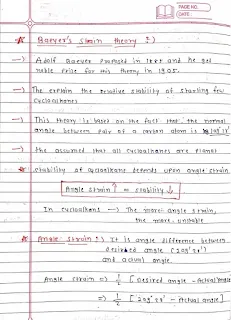Baeyer’s Strain Theory & Angle Strain - Organic Chemistry 2 (B.Pharm 3rd Sem)
Access comprehensive handwritten notes on Baeyer’s Strain Theory and its application to cycloalkanes. Ideal for B.Pharm 3rd Semester Organic Chemistry 2 students, these notes provide a clear understanding of angle strain and its implications.
Key Concepts Explored:
- Detailed explanation of Baeyer’s Strain Theory and Angle Strain.
- Analysis of angle strain in Cyclopropane, Cyclobutane, Cyclopentane, and Cyclohexane.
- Structural insights into various cycloalkanes.
- Critical discussion on the Limitations of Baeyer’s Strain Theory.
These notes are perfect for grasping fundamental concepts of conformational analysis and stability of cyclic compounds. Download this free PDF to enhance your understanding and excel in your organic chemistry studies.
Keywords:
Baeyer’s Strain Theory PDF, Angle Strain Theory, Cyclopropane Strain, Cyclobutane Strain, Cyclopentane Stability, Cyclohexane Conformations, Organic Chemistry 2 Notes, B.Pharm 3rd Sem Notes, Handwritten Chemistry Notes, Download Chemistry PDF, Free Organic Chemistry Notes, Cycloalkane Stability, DuloMix Slides.
Unraveling Cycloalkane Stability: A Comprehensive Look at Baeyer’s Strain Theory
Baeyer’s Strain Theory, proposed by Adolf von Baeyer in 1885, was one of the earliest attempts to explain the stability and reactivity of cyclic organic compounds, particularly cycloalkanes. This theory, though having its limitations, laid the groundwork for understanding the conformational complexities of rings and remains a fundamental concept taught in Organic Chemistry 2 for B.Pharm 3rd-semester students. Our meticulously prepared handwritten notes provide an in-depth exploration of this theory, its applications, and its eventual limitations.
The Core of Baeyer’s Strain Theory: Angle Strain
Baeyer's theory posits that the stability of a cyclic compound depends on the deviation of its internal bond angles from the ideal tetrahedral angle of 109.5°. This deviation causes "angle strain." The larger the deviation, the greater the strain, and consequently, the less stable the ring system. He assumed that all cycloalkanes are planar, which was later proven incorrect for larger rings but was a crucial starting point for his hypothesis.
Angle Strain in Different Cycloalkanes:
- Cyclopropane (C₃H₆): With internal angles of 60°, the deviation from 109.5° is significant (49.5°). This large angle strain makes cyclopropane highly reactive and unstable, prone to ring-opening reactions. Our notes illustrate the structure and explain this extreme strain.
- Cyclobutane (C₄H₈): The internal angles are approximately 90°. While less strained than cyclopropane (deviation of 19.5°), it still experiences considerable angle strain. Cyclobutane is not perfectly planar; it adopts a slightly bent (puckered) conformation to minimize some of this strain, a detail covered in the notes.
- Cyclopentane (C₅H₁₀): For a planar cyclopentane, the internal angles would be 108°. This is very close to the ideal tetrahedral angle, suggesting minimal strain according to Baeyer. Indeed, cyclopentane is relatively stable. However, our notes also discuss how it adopts "envelope" or "half-chair" conformations to relieve some minor torsional strain.
- Cyclohexane (C₆H₁₂): Baeyer predicted that cyclohexane, if planar, would have internal angles of 120°, leading to considerable angle strain. However, cyclohexane is known to be remarkably stable. This apparent contradiction was one of the major points of disagreement with Baeyer’s planar assumption. Modern understanding, detailed in the notes, shows that cyclohexane adopts a non-planar "chair" conformation, where all bond angles are close to 109.5°, making it virtually strain-free.
Limitations of Baeyer’s Strain Theory:
Despite its foundational importance, Baeyer’s Strain Theory has significant limitations, which are critically examined in our notes:
- Planar Assumption: The most significant flaw was the assumption that all cycloalkanes are planar. Larger rings (like cyclohexane and beyond) are not planar; they adopt puckered, non-planar conformations (e.g., chair, boat, twist-boat) to alleviate angle strain and torsional strain (eclipsing interactions between adjacent hydrogen atoms).
- Overestimation of Strain: Baeyer's theory incorrectly predicted that rings larger than cyclopentane would become progressively more strained. In reality, rings like cyclohexane and even larger rings can adopt strain-free or low-strain conformations.
- Ignored Torsional Strain: The theory only considered angle strain and overlooked torsional strain, which arises from unfavorable eclipsing interactions between substituents on adjacent carbons. This type of strain is significant in smaller rings like cyclopropane and cyclobutane and is completely absent in the staggered conformation of cyclohexane.
Conclusion:
While Baeyer’s Strain Theory provided an initial framework for understanding cyclic compounds, modern conformational analysis, which considers both angle and torsional strain, offers a more accurate picture of cycloalkane stability. These handwritten notes offer a clear explanation of Baeyer's original theory, its application to various ring sizes, and its crucial limitations, making them an indispensable resource for B.Pharm students aiming to master organic chemistry concepts. Download your free PDF today and deepen your understanding of these fundamental principles.
Info!
If you are the copyright owner of this document and want to report it, please visit the copyright infringement notice page to submit a report.

